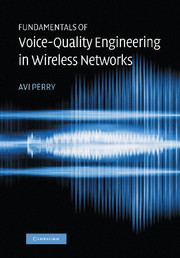Book contents
- Frontmatter
- Contents
- Preface
- List of abbreviations
- Introduction
- Part I Voice-quality foundations
- Part II Applications
- 3 Electrical echo and echo cancelation
- 4 Acoustic echo and its control
- 5 Noisy ambience, mobility, and noise reduction
- 6 Speech-level control
- Part III Wireless architectures
- Part IV A network operator's guide for selecting, appraising, and testing a VQS
- Part V Managing the network
- Part VI Afterthoughts and some fresh ideas
- Part VII Recordings
- Glossary of common voice-quality systems terminology
- Brief summary of echo cancelation and VQS major standards
- Brief summary of key voice-quality assessment standards
- Bibliography
- Index
3 - Electrical echo and echo cancelation
Published online by Cambridge University Press: 24 May 2010
- Frontmatter
- Contents
- Preface
- List of abbreviations
- Introduction
- Part I Voice-quality foundations
- Part II Applications
- 3 Electrical echo and echo cancelation
- 4 Acoustic echo and its control
- 5 Noisy ambience, mobility, and noise reduction
- 6 Speech-level control
- Part III Wireless architectures
- Part IV A network operator's guide for selecting, appraising, and testing a VQS
- Part V Managing the network
- Part VI Afterthoughts and some fresh ideas
- Part VII Recordings
- Glossary of common voice-quality systems terminology
- Brief summary of echo cancelation and VQS major standards
- Brief summary of key voice-quality assessment standards
- Bibliography
- Index
Summary
Chapter 3 provides an overview of echo in telecommunications networks, its root causes, and its parameters. It follows the presentation with the methods used for controlling electrical echo, including network loss, echo suppression, linear convolution, non-linear processing, and comfort noise injection. The chapter covers the application of echo cancelation in wireless communications. And, in view of the fact that today's wireless networks include long-distance circuit switched, VoIP, and VoATM infrastructures (specifically as part of third-generation architectures), the chapter covers echo cancelation in long-distance and voice-over-packet applications.
Electrical echo
Many people have never experienced echo on a telephone call. They either never made calls outside their vicinity, or never encountered a malfunctioning echo canceler on their long-distance or wireless calls. In reality, echo does exist in the network. It accompanies every call involving an analog PSTN phone, but in most cases it either gets canceled before reaching its listening ear or it arrives too quickly with little delay, so it can sneak in undetected.
To hear an echo, we must first generate a sound. Then the sound must travel over a substantial distance or a slow terrain (a.k.a. complex processing) to accumulate delay. Next, the sound must be reflected and then travel back towards us. Finally, when the reflected sound reaches our ear, it must be loud enough to be heard. In addition, the amount of delay that the original sound signal incurs influences our perception of “reverberated echo” (i.e., increasing delay produces a greater echo effect).
- Type
- Chapter
- Information
- Publisher: Cambridge University PressPrint publication year: 2006



